One of the salient aspects of the exhibition Colors and Forms of Work at Palazzo Cucchiari in Carrara (June 16 to October 21, 2018) concerns the exhibition’s emphasis on women’s work in the period examined (i.e., the decades from the Unification of Italy to the first decade of the 20th century) and on the condition of women in the working environments of the time. A wide range of scientific and sectorial literature has been developed on the subject (publications aimed at the general public, on the other hand, are less frequent), giving us a picture of an Italy in which the role of women in work was fundamental and decisive, as much in the industrialized cities as in the countryside that still lived according to ancient traditions and rhythms. To give an idea of how important women’s work was, it is possible to cite the number of female workers, over the age of ten, surveyed in the city of Milan: it turns out that in 1881 54 percent of the female population was employed, which then dropped to 50.5 percent in 1901 and 42 percent in 1911. However, in the face of such a vast number of working women, their wage conditions were not even comparable to those of men: typically, in the mid-19th century it was normal for a woman, for the same number of hours worked (or working slightly less than her male counterpart), to receive half the salary of a man. A custom that would characterize the entire late 19th century, which would continue until the years leading up to World War I, and which was not typical of any particular area: it was widespread in several European countries, including Italy. Worse off than women were only the boys, the minors, who as is known filled the fields and factories of post-unification Italy and would continue to do so for a long time.
This discrimination, as well explained by the late historian Simonetta Ortaggi, one of the sharpest Italian scholars of the history of labor organization, stemmed as much from the way work was structured at the time (and the resulting mentality) as from customs and mores. A few examples: women from the working classes could find husbands more easily if they were employed (due to the fact that in this way the woman would weigh less on the family budget, or the fact that in this way she would be able to put aside the money needed for a dowry without burdening her parents: in Piedmont there was a proverb that read “woman at the loom, husband without trouble”), and they were considered socially more deserving of attention than those who did not work. As for the mentality of the time, the custom of paying lower wages to women also prevailed in view of the fact that entrepreneurs valued what they saw as a risk: the fact that women, once they had found a husband and were thus distracted from domestic work or childcare (according to the mentality of the time, the role of mother and that of worker outside the family sphere were practically incompatible), might abandon employment in the factory or in the fields. As a result, the vast majority of those employed in factories were often no older than 30, partly because there was nonetheless, in early twentieth-century Italy, a law, enacted in 1902 (the Carcano Law), that did not allow women who had just given birth to return to work until a month after giving birth, but at the same time did not give them guarantees about the possibility of regaining the work they were doing (these would come only a few years later). Still, in many industries the number of women often exceeded the number of men: this was for reasons related to the consideration of the female character at the time, as well as to the type of activities to be performed in the work context. Women, in fact, were often preferred to men because they were considered more diligent, easily controlled and tame (and of course because, for the reasons listed above, they were less expensive), and because they were thought to be better predisposed to perform certain jobs (the simple, mechanical and repetitive ones, but no less heavy than men’s jobs) that the new machines required, while men were mostly reserved for hard labor.
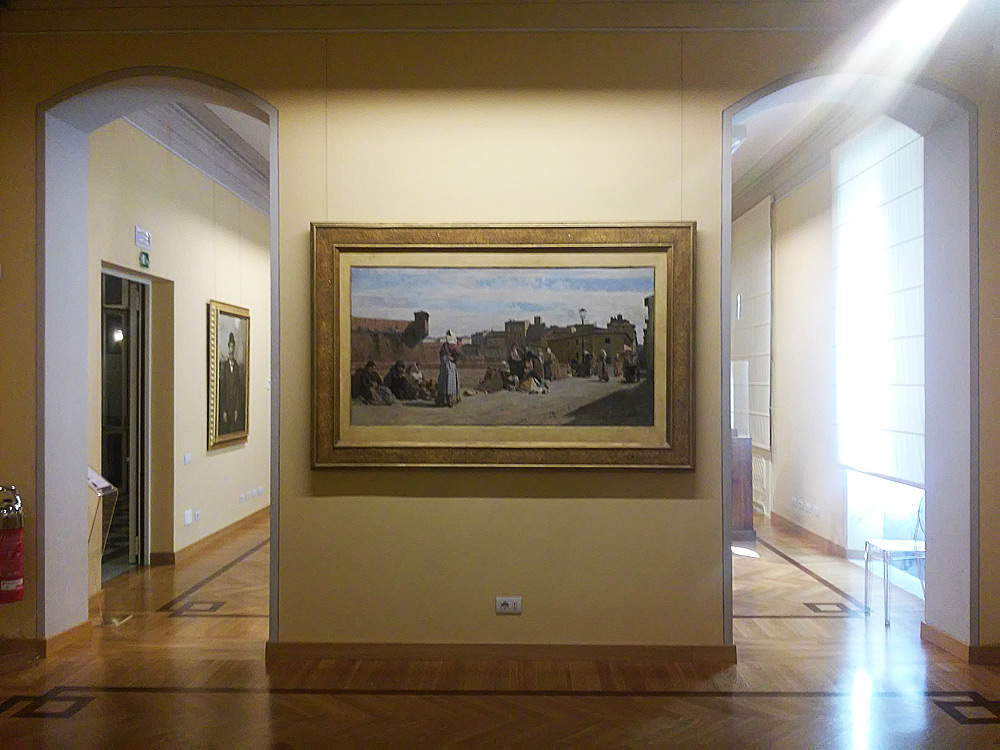 |
| A room in the exhibition Colors and Forms of Work in Carrara, Palazzo Cucchiari |
In any case, recent studies have also shown how the dense presence of women in the labor system at the end of the 19th century contributed to the formation and shaping of a new female identity: contacts with realities outside the narrow family sphere, and participation in workers’ movements and agitations gradually led women (European and Italian, especially in the large industrial cities) to become aware of their condition, to acquire awareness of their rights, and to secure greater autonomy from the roles to which the institution of the family intended to relegate them. It was above all the experience in the factories that pushed women toward a new self-awareness: in such contexts, women workers could realize their own abilities, and experience new kinds of relationships that were precluded to them in the narrow family environment (think of what it could mean, for a woman of the late 19th century, until then essentially relegated to the domestic walls or to simple neighborhood relationships, to share her experience with her colleagues within a large reality). There was also an increase in the presence of women in trade unions however, even at the beginning of the twentieth century, and even within the trade unions themselves, the prejudice that work in factories was not suitable for women, who should, if anything, have devoted themselves to the care of the home, was ingrained.
And it was precisely within the home, moreover, that much of women’s work took place. Domestic work, while enjoying little social consideration, was vital to the family economy: important resources for the family’s sustenance were drawn from domestic work, both when women worked for the strict needs of the family and when they performed work on commission (although historiography has by now largely found that, very often, home-based work was in any case insufficient to ensure a decent existence for the woman and her family). These were mainly jobs related to craft skills that were handed down from generation to generation and for which there was, between the nineteenth and twentieth centuries, and especially in northern Italy and the large cities, a sharp increase in demand, due to the fact that the new urban bourgeoisie, historian Alessandra Pescarolo has written, “fed an incredibly varied demand for objects, functional or ornamental, shaped in any case by an aesthetic sensibility charged with decorativism, that were produced manually at home without any concern for the rationalization and standardization that mechanization would later impose.” Women, therefore, often worked at home as seamstresses, sewers, spinners, embroiderers, bookbinders, toy-makers, lace-makers, and assorted accessories. However, these were very low-cost activities that leveraged, according to Pescarolo, the “willingness of women of the urban proletariat to the extreme waste of themselves and their energies.”
The curators of the aforementioned Carrara exhibition, Ettore Spalletti and Massimo Bertozzi, decided to open the show precisely with a section devoted to domestic labor. What is evident when observing many of the paintings depicting women at work at home is the absence of any intent of social criticism: this is because, Bertozzi wrote in the exhibition catalog, the lack of relevance that domestic work enjoyed among contemporaries meant that such activities were looked at by painters “as aspects of custom rather than social contexts: inevitably, domestic work, as well as work performed at home, work in the workshop and rural work, would still remain excluded from any legislation of social protection and welfare for a very long time.” The sad and resigned appearance of the Spinner painted by the Milanese Gerolamo Induno (Milan, 1825 - 1890), who waits at her spinning work in a bare and dirty domestic interior, with peeling walls and objects thrown on the floor littering the floor, is a kind of unintentional manifesto of the condition of the female domestic worker in the years immediately following the Unification of Italy (unintentional because probably the artist, with his narrative meticulousness acknowledged even by his contemporary critics, aimed to faithfully reproduce a moment of daily life, to paint a gendered scene devoid of any political connotation, rather than to make social denunciation). The same could be thought of Niccolò Cannicci ’s (Florence, 1846 - 1906) Filatrice, animated by the desire to restore to the subject a faithful portrait of a commoner standing with a spindle in her hand, a typical tool of her mesteire. And if Egisto Ferroni ’s Gomitolo (Lastra a Signa, 1835 - Florence, 1912), with the tender child attempting to snatch from his mother the ball of yarn with which she is working, introduces a delicate affectionate vein that inextricably links work at home to the sphere of the family, the great Silvestro Lega (Modigliana, 1826 - Florence, 1895) depicts a Bigherinaia (a maker of bigherini, trimmings of lace for women’s clothing) waiting at her work solitary and melancholy, in front of a large loom. When one considers that in an 1880 study conducted by Vittorio Ellena (who twelve years later would become finance minister in the first Giolitti government) as many as 229,538 home looms had been surveyed in almost all of Italy, one can easily imagine how common scenes like those painted by the painters listed above were.
At the Carrara exhibition, the necessary work for the family is exemplarily depicted by two artists such as Eugenio Cecconi (Livorno, 1842 - Florence, 1903) and Llewelyn Lloyd (Livorno, 1879 - Florence, 1949), the former with the Washerwomen at Torre del Lago and the latter with the Net Hairdressers. The washerwomen, who mostly washed the clothes of the members of the household (but not infrequently worked on commission), are depicted in Cecconi’s painting as they carry out their work by taking advantage of the waters of Lake Massaciuccoli, in a group (washing clothes was, after all, one of the most important moments of socialization for the women of the time, who had in this way the opportunity to exchange a few words with their neighbors). Lloyd, a Leghorn artist of Welsh descent, bears witness to an important moment in the life of a seaside village: the mending of nets by fishermen’s wives (nets were a fundamental tool for the economy of these places, and mending was necessary to prevent fishermen from having to buy new ones, burdening the family budget).
 |
| Gerolamo Induno, The Spinner (1863; oil on canvas, 65.5 x 52.2 cm; Genoa, Gallery of Modern Art) |
| <img src=’https://cdn.finestresullarte.info/rivista/immagini/2018/904/niccolo-cannicci-la-filatrice.jpg ’ alt=“Niccolò Cannicci, The Spinner (1885-1890; oil on cardboard, 57 x 24 cm; Milan, Museo Nazionale Scienza e Tecnologia <a href=”https://www.finestresullarte.info/arte-base/leonardo-da-vinci-vita-opere“>Leonardo da Vinci</a>) ” title=“Niccolò Cannicci, The Spinner (1885-1890; oil on cardboard, 57 x 24 cm; Milan, Museo Nazionale Scienza e Tecnologia Leonardo da Vinci) ” /> |
| Niccolò Cannicci, The Spinner (1885-1890; oil on cardboard, 57 x 24 cm; Milan, Museo Nazionale Scienza e Tecnologia Leonardo da Vinci) |
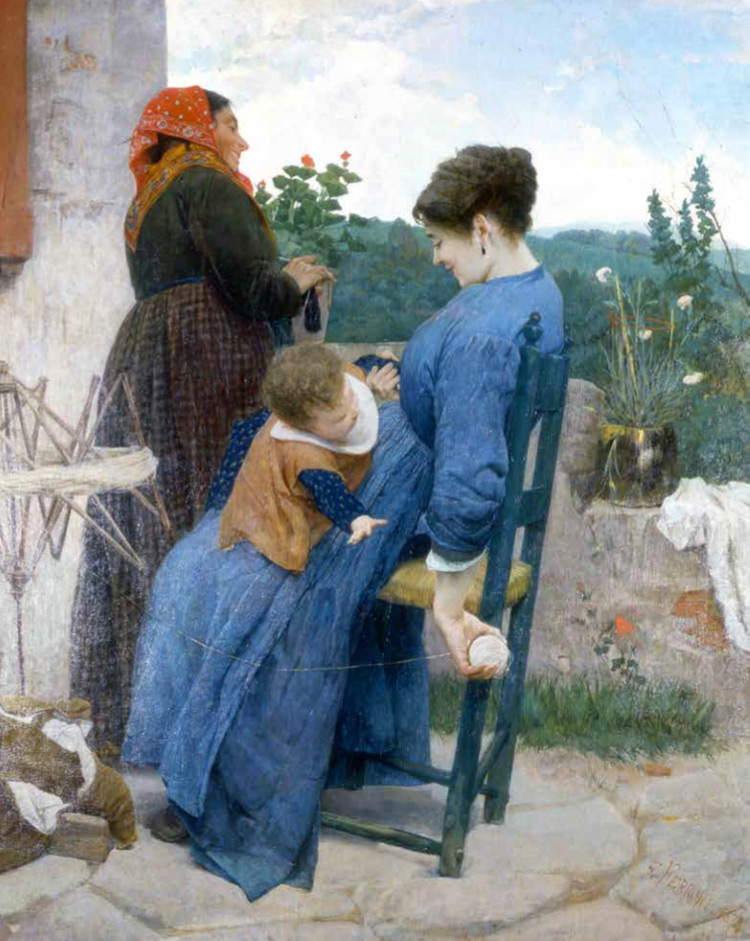 |
| Egisto Ferroni, Il gomitolo o Scena di famiglia o Le tre età (1874; oil on canvas, 145 x 120 cm; Bologna, Private Collection) |
 |
| Silvestro Lega, La bigherinaia (1883; oil on canvas, 33.7 x 24.7 cm; Viareggio, Società di Belle Arti) |
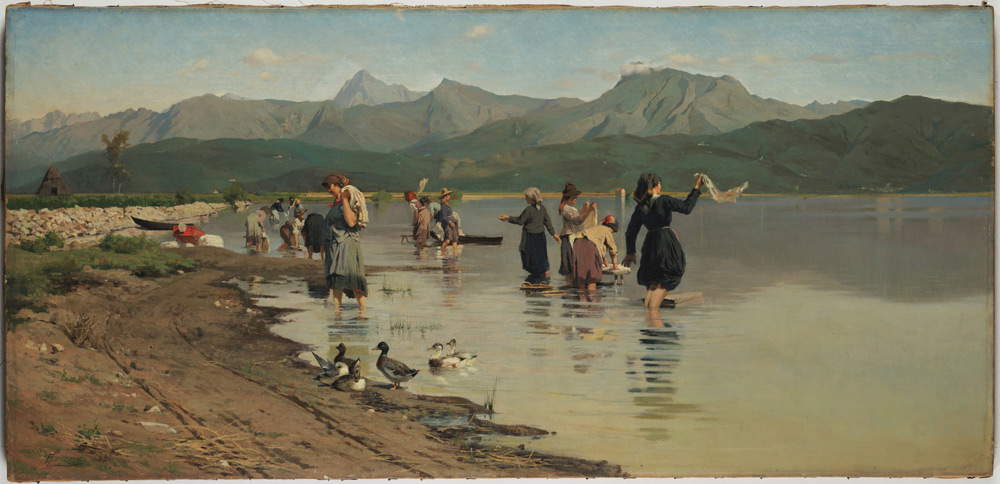 |
| Eugenio Cecconi, Laundresses at Torre del Lago (1880; oil on canvas, 50.5 x 106.5 cm; Milan, Museo Nazionale Scienza e Tecnologia Leonardo da Vinci) |
 |
| Llewelyn Lloyd, Old Net Hairdressers (1907; oil on canvas, 93.4 x 129.5 cm; Viareggio, Society of Fine Arts) |
As for work in the countryside, this was another sector that was essentially unprotected for women workers, not least because the vast majority of them always worked in the family, perhaps providing help to their husbands or fathers, who were responsible for the harder tasks. And they were often women who went to the fields after waiting for spinning and embroidery work at home: partly because of this ambiguity in defining themselves as spinners or peasants, it made it difficult for those in charge of worker censuses at the time to obtain reliable statistics on the employment of women in agriculture. Women were assigned to jobs thought to be easy, although in reality this was often not the case, and although certain jobs had the reputation of being light, performed over a full day they became hard and wearing: think, for example, of the work of the mondine (perhaps the most “famous” agricultural workers of the time), the women who, in late spring, would go to the flooded rice fields to perform the “monda,” or the removal of weeds that would cause damage to the crops by preventing the development of the young rice seedlings (a job later overcome thanks to the introduction of herbicides). Women were thus entrusted with such tasks as harvesting (of grapes, olives, chestnuts, fruit, vegetables, and wood), gleaning (i.e., picking up from the ground the ears of grain that had escaped harvesting), cleaning certain plants, and weeding (the pest control of weeds in plowed fields).
The painters were keen observers of the reality of the time: they were often aseptic and distant, as imposed by the canons of realist and verist painting of the time, but the widespread presence of humble subjects, such as workers in the fields, in their works, as the years went by led the new generations to elaborate art forms closer to the instances of the subjects depicted and capable of stronger social criticism. An artist such as Telemaco Signorini (Florence, 1835 - 1901) moved between these two poles: capable of works imbued with social criticism fueled by his readings (an exemplary case is theAlzaia preserved in a private collection), he was also, however, fascinated by the countryside of Settignano, a locality on the outskirts of Florence that the artist habitually frequented. As a result, a work like The Olive Harvest turns out to be permeated with a poetic afflatus (the beauty of the landscape, the atmosphere, the detail, though frequent in Signorini, of the child sitting on the lawn) that almost makes one forget what the condition of women in the fields was. Animated by more descriptive intentions, on the other hand, is D’ottobre verso sera, a painting by Adolfo Tommasi (Livorno, 1851 - Florence, 1933) that testifies to the end of a working day in the fields: it is very interesting because the woman laboriously dragging the wagon in the center of the scene, in the distance, testifies to how women, too, often had to do strenuous work (for example, when their husbands had to absent themselves from the fields for a variety of reasons, or in any case if male labor was scarce). Also by Adolfo Tommasi are the Boscaiole a riposo (Woodcutters at Rest), another painting that ranks among the genre paintings and unequivocally demonstrates how women’s work (again quite strenuous: it was women who were responsible for gathering wood into bundles and transporting it to shelter) fell as much to the young as to the old. Indeed: often, a woman of advanced age was considered a better worker than a younger one, both because of her experience and (above all) because she did not risk being absent from work to look after her children.
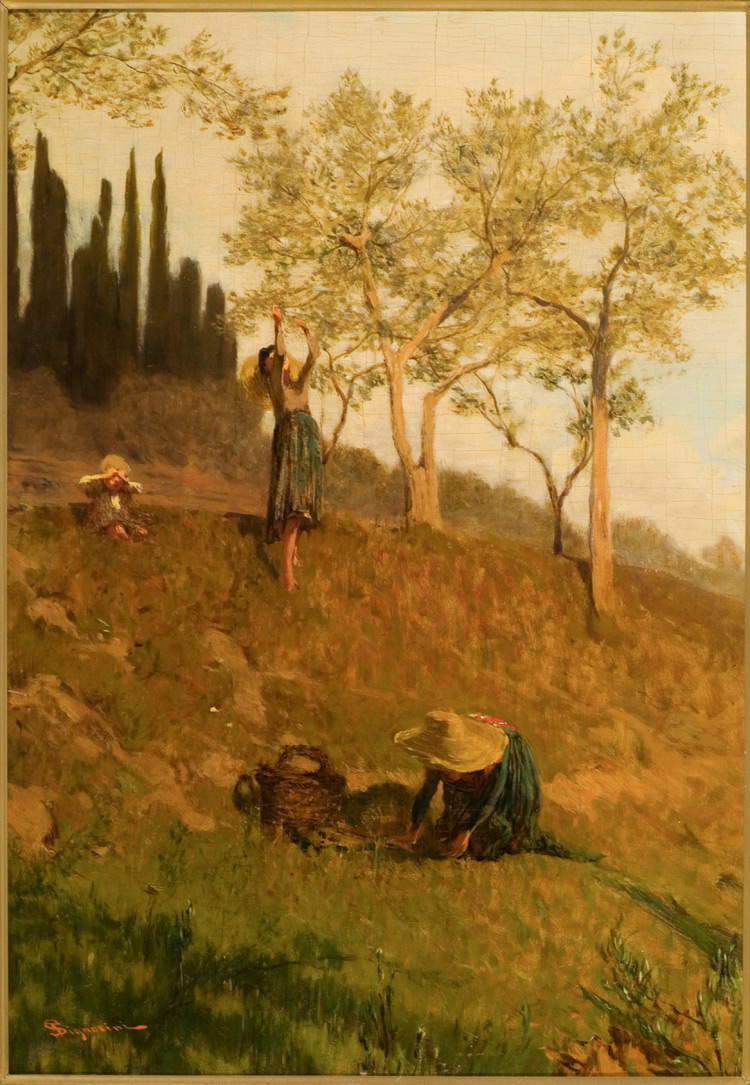 |
| Telemaco Signorini, The Olive Harvest (ca. 1862-1865; oil on canvas, 51.3 x 36.2 cm; Bari, Pinacoteca Metropolitana Corrado Giaquinto) |
 |
| Adolfo Tommasi, D’ottobre verso sera (c. 1885-1888; oil on panel, 50 x 100 cm; Viareggio, Società di Belle Arti) |
 |
| Adolfo Tommasi, Two Lumberjacks at Rest (1893; oil on canvas, 115 x 120 cm; Livorno, Goldoni Art Gallery) |
Many women also found employment in commerce: however, we are almost always talking about the minute sale of foodstuffs, handicrafts or items for the home and everyday life. Sales were made at market stalls or, more simply, with stalls in the squares or on the streets. Often, moreover, trade was almost configured as a complementary activity to that of men: this is evident in a painting such as The Old Fish Market by the Venetian (but Neapolitan-born) painter Ettore Tito (Castellammare di Stabia, 1859 - Venice, 1941). It is a genre scene tackled by the painter with a verist flair, and in which the women fishermen of the Venetian lagoon, after the arrival of their men, display their catch in large baskets in a kind of market set up directly on the banks of a canal. Even jobs in the trade often escaped protection or forms of associationism: it was only between 1907 and 1910 that women merchants (who, according to a 1911 census, numbered more than thirteen thousand in Italy) would be admitted to the active and passive electorate of the organs of the Chambers of Commerce, and also from the same period came the first regulations that removed married women who intended to work in the field of sales from the authority of their husbands (the husband, in fact, had to express his consent if his wife wished to engage in commercial activity). However, that of women remained, almost always, a poor trade, widely documented by artists of the time: Particularly illustrative are works such as Eugenio Cecconi’s Cenciaiole livornesi, a painting depicting rag-sellers from Livorno’s poor quarters (and a painting that, wrote art historian Valentina Gensini, manifests obvious “concerns of a social and ethical nature” by proposing an image not unrelated “to the pathetically affectionate and suffering approach practiced by Tuscan artists toward nature and its manifestations independent of the subjectivity of the observer”), Luigi Serra ’s Coronari a San Carlo dei Catinari (Bologna, 1846 - 1888), which depicts a typical trade in the neighborhoods of Rome close to the Vatican (there is also a very famous “via dei Coronari” near Piazza Navona), that of sacred objects such as crucifixes, rosaries and crowns that were sold to pilgrims on their way to St. Peter’s (Serra’s work is a masterpiece where the author seems, like Cecconi, sympathize with the condition of the humble merchants, stooped and melancholy before their own poor banquets), or the Venditrice di frutta by Libero Andreotti (Pescia, 1875 - Florence, 1933), a sculpture already projected toward modernity.
Finally, the work of women in factories, industries and plants is magnificently represented by an artist like Lombard Eugenio Spreafico (Monza, 1856 - 1919), who was particularly interested in the theme of women’s work, to which he dedicated several paintings. In his Dal lavoro. The Return from the Spinning Mill, Spreafico depicts a group of women walking together on their way back from the spinning mill where they work, silhouetted by their profiles against the beautiful sunset of the Lombardy countryside, in an avenue that runs through the fields taken horizontally by the artist. It is a painting steeped in suggestion, and such as to have perhaps inspired a celebrated masterpiece such as Giuseppe Pellizza da Volpedo’s Quarto Stato (which has an identical cut to Spreafico’s, albeit closer and despite, of course, being a work animated by quite different intentions), but at the same time it is devoid of any desire for social denunciation. The gait of the women workers, in fact, blends with the magnificent landscape over which the dusky light reflects on the canals at the edge of the avenue and on the puddles that have formed in the furrows left by the wagons, and this helps to dilute any possible moment of tension: the work of Spreafico, a verist painter, is aimed at presenting the viewer with a piece of reality, documented according to objective tones. But it is also interesting to think that these women, tired and fatigued by the hours of work in the spinning mill and nevertheless glad to share the way back by chatting and perhaps joking with some of their colleagues, could also represent a metaphor, suggested art historian Elisabetta Piazza, of “a better future, toward which they walk confidently.”
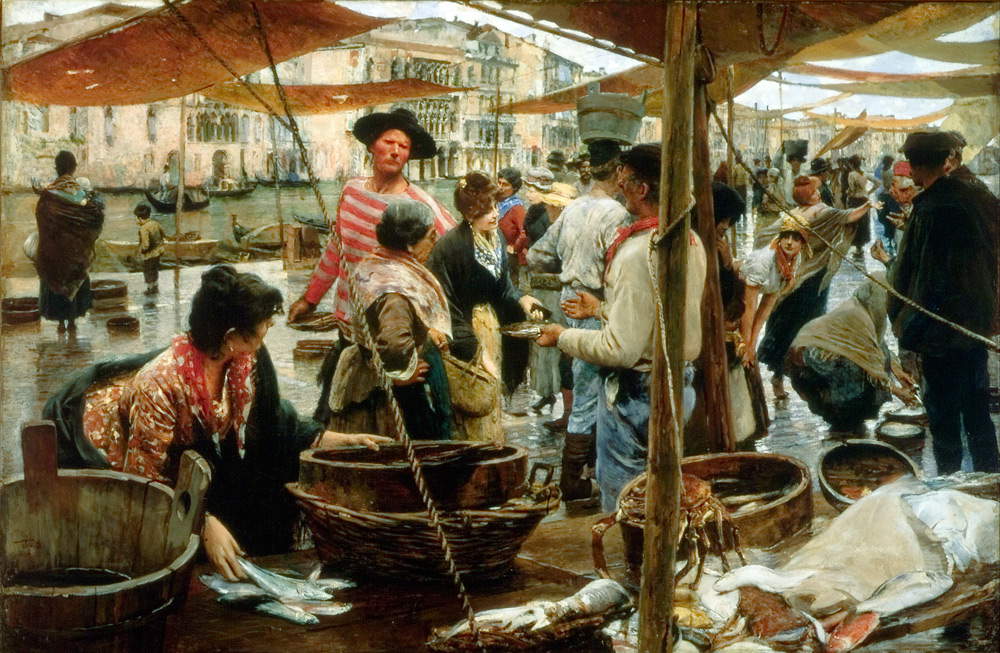 |
| Ettore Tito, The Old Fish Market (1893; oil on canvas, 130 x 200 cm; Rome, National Gallery of Modern and Contemporary Art) |
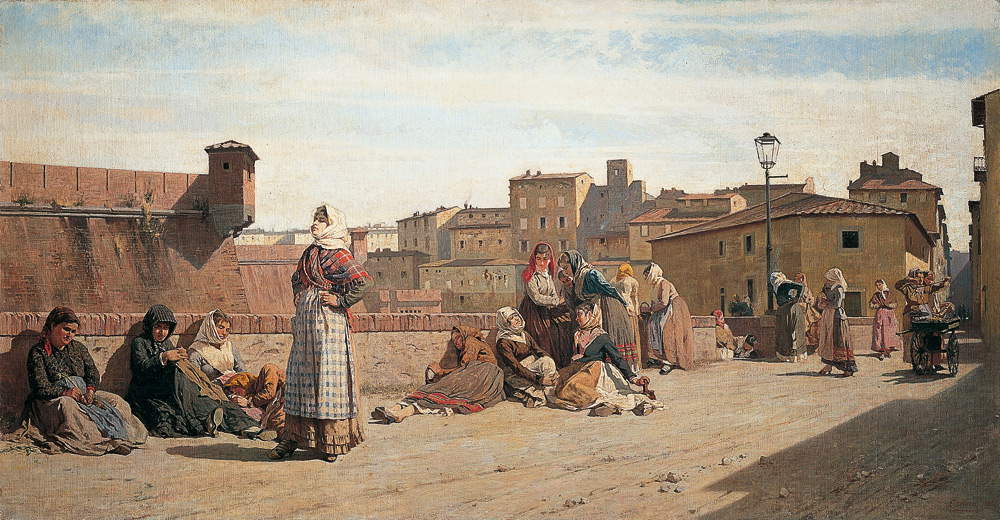 |
| Eugenio Cecconi, Cenciaiole livornesi (1880; oil on canvas, 88 x 170 cm; Livorno, Museo Civico Giovanni Fattori) |
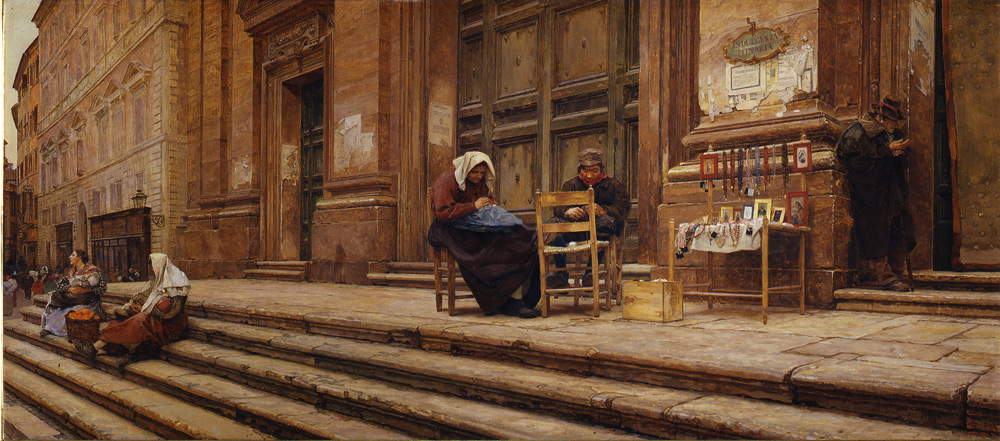 |
| Luigi Serra, I coronari a San Carlo dei Catinari (1885; oil on canvas, 57 x 129 cm; Florence, Uffizi Galleries) |
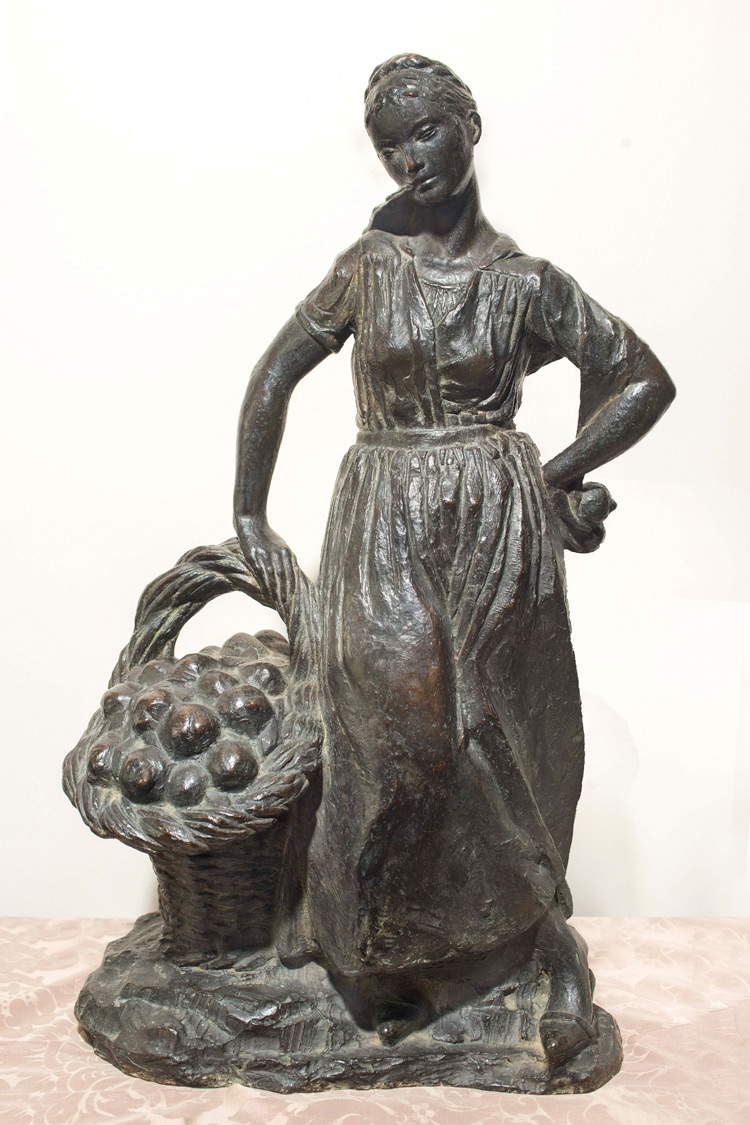 |
| Libero Andreotti, Venditrice di frutta (1917; bronze, 70 x 42 x 27 cm; Florence, Private Collection) |
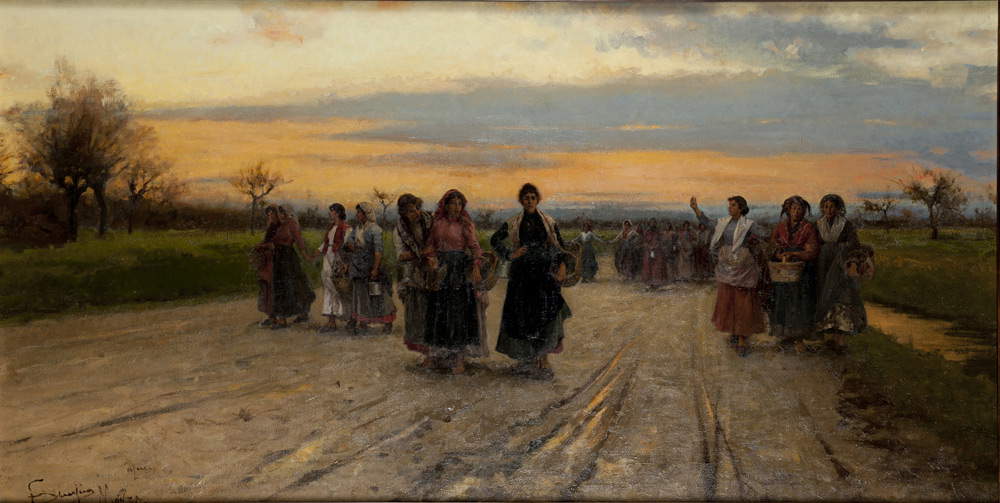 |
| Eugenio Spreafico, From Work. Returning from the spinning mill (1890-1895; oil on canvas, 101 x 194.5 cm; Monza, Musei Civici) |
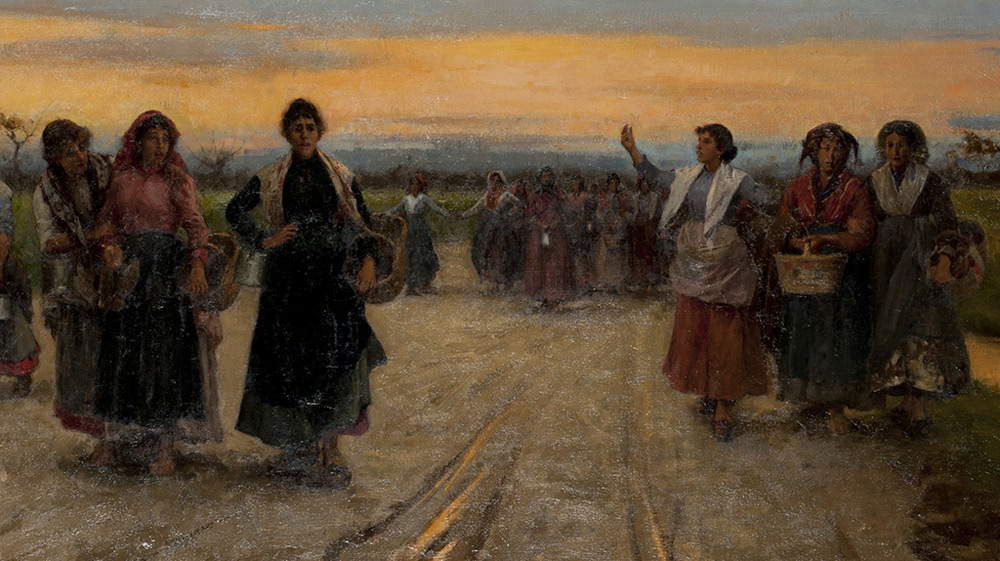 |
| Eugenio Spreafico, From Work. The return from the spinning mill, detail |
In the wake of the activity of artists increasingly animated by social instances (think of the aforementioned Pellizza da Volpedo, but also of great painters and sculptors such as Plinio Nomellini, Angelo Morbelli, Vincenzo Vela, Patrizio Fracassi and many others), as well as of the literati of the time, the period immediately between the two centuries signaled improvements in working conditions, and it was also the time when the so-called women’s question emerged as an object of public discussion. Journalists, artists, philosophers and writers had long denounced the conditions to which women were forced: Remaining in the field of literature one could cite the works of John Stuart Mill who in 1869, with The Subjection of Women, spread the message that the subordination of women to men was nothing but a form of slavery, or those of Jules Michelet who, although criticized by feminists for his ideal of a woman as a “gentle mediator between nature and man,” nevertheless had the merit of claiming fundamental rights for her, first and foremost that of not being a kind of passive object totally dependent on men’s authority and lacking her own capacity for self-determination. Again, mention could be made of the writings of Jules Simon, who in his L’ouvrière of 1861, although still bound, albeit in good faith, to the idea of women subject to the power of their husbands, denounced the conditions of women’s work in factories, suggesting that work in industries was not suitable for them, and that women should, if anything, be protected. In Italy, the studies of Salvatore Morelli, a convinced and very modern advocate, ahead of his time, of equality between men and women, were fundamental: as early as 1867 Morelli lamented that women were not allowed to vote, that in the work sphere they were precluded from any possibility of career advancement, and that they could not give their surnames to their children, and in 1869, in his seminal work La donna e la scienza, he wrote that the exclusion “of woman from all offices is a marked contempt to the dignity of a moral being, it is subtraction from the human family of four hundred and fifty million intelligences, and if one wants to touch a little on the summum jus, I will say, it is an open invalidation of the acts of man as a legal person. One way or the other, either one considers woman as half of man, and then all acts performed so far must be judged imperfect, because human perfection is accomplished with the help of woman [...] or one must consider it as containing in itself its own personality, and then woman is part of society, if she is also a citizen, if in social relations there are also interests for her.”
Thanks to the direct initiative of Morelli (who was also an MP for four terms), an 1877 law allowed women to become witnesses in public and private acts. It took many more years, however, before the first advances in women’s labor conditions began to be recorded in Italy. The Carcano Law of 1902 set the maximum limit of the working day for women at twelve hours (with a two-hour break), forbade night work for minors and underground work for all, introduced a mandatory leave of four weeks after childbirth and allowed breastfeeding in the workplace, requiring industries employing at least fifty female workers to set up special rooms or to grant special permits. Law 520 of 1910 established a Maternity Fund that guaranteed a subsidy to women on compulsory leave under the 1902 law. Finally, it had to wait until 1919 (with Law 1176, “Norms Concerning the Legal Capacity of Women”) for the abolition of the right of husband’s opposition and for women to be granted access to all professions and public employment. These were women’s first steps on the long road to equality.
Reference bibliography
Warning: the translation into English of the original Italian article was created using automatic tools. We undertake to review all articles, but we do not guarantee the total absence of inaccuracies in the translation due to the program. You can find the original by clicking on the ITA button. If you find any mistake,please contact us.